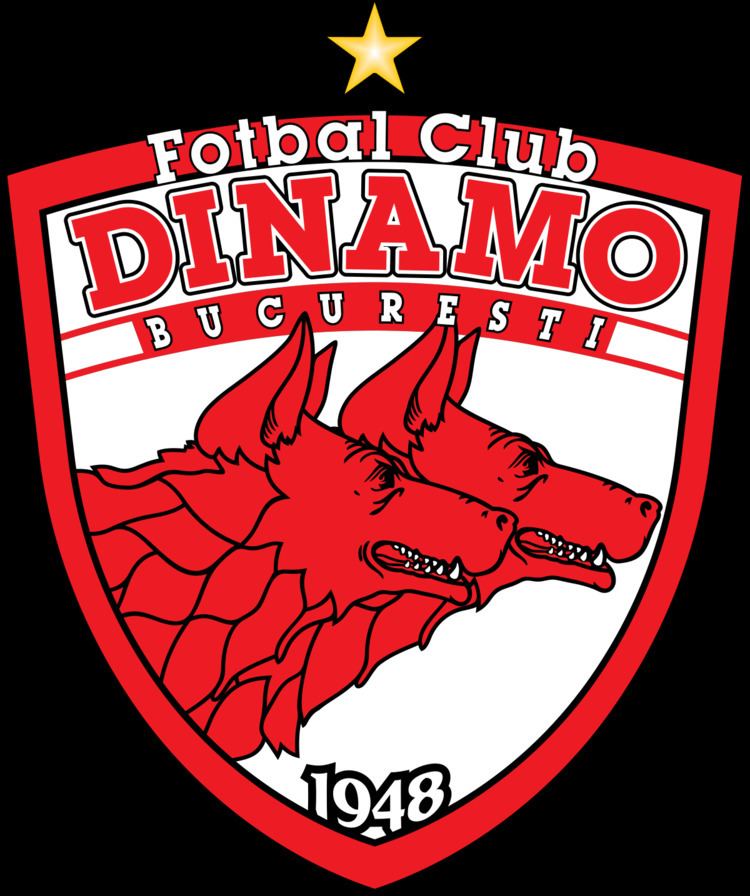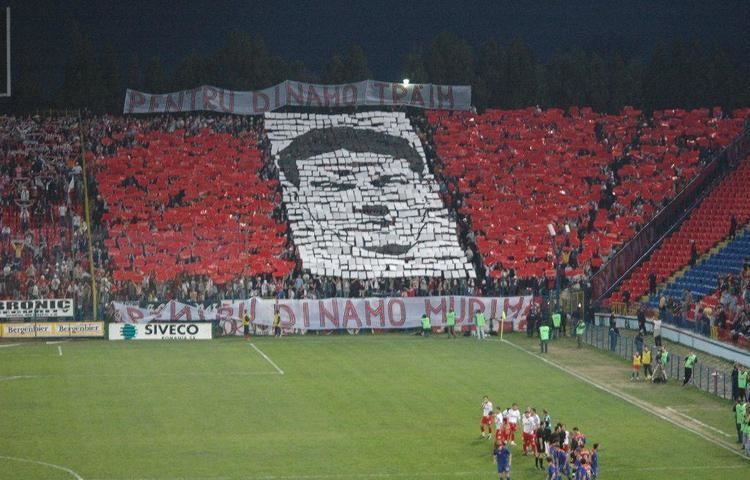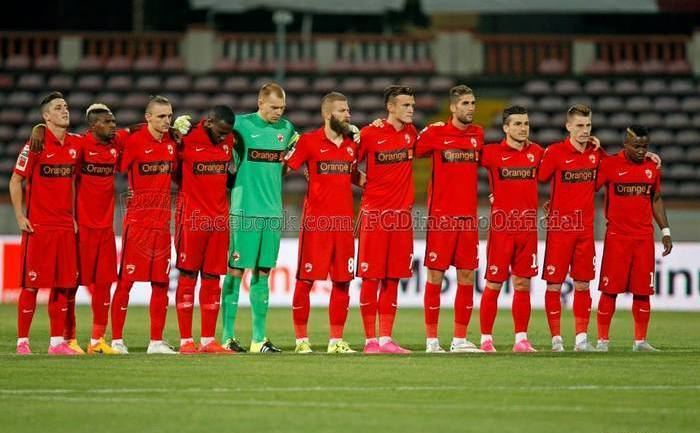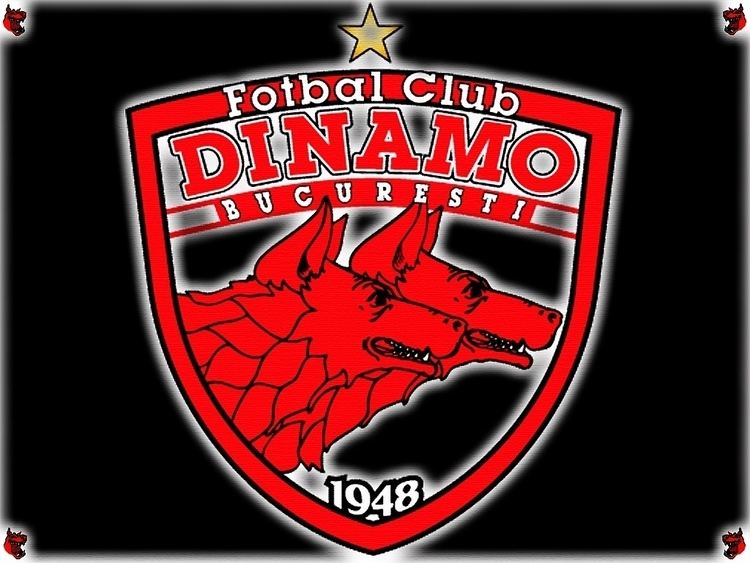Short name Dinamo Ground Capacity 15,032 League Liga I Location Bucharest, Romania | Ground Stadionul Dinamo Owner Ionuț Negoiță Manager Cosmin Contra Chairman Adrian Mutu | |
 | ||
Full name Fotbal Club Dinamo București Nickname(s) Câinii roșii (The Red Dogs)
Alb-roșii (The White and Reds) Founded 14 May 1948, Bucharest, Romania Arenas/Stadiums National Arena, Stadionul Dinamo Profiles | ||
Fotbal Club Dinamo București ([diˈnamo bukuˈreʃtʲ]), commonly known as Dinamo București, or simply as Dinamo within Romania, is a professional Romanian football club based in Bucharest.
Contents
- History
- Club badge and colours
- Stadium
- Supporters
- Rivalries
- Youth program
- Leagues
- Cups
- First team squad
- Out on loan
- Retired numbers
- European record
- Notable players
- Notable managers
- References

Founded in 1948, Dinamo has spent its entire history in Liga I, the top tier of the Romanian football league system. Domestically, Dinamo is one of the two most successful teams in Romania, having won 18 Liga I titles, 13 Cupa României (Romanian Cups), and 2 Supercupa României (Romanian Supercups). In the 1983–84 season, they became the second Romanian club to reach the semi-finals of the European Cup.

Dinamo's traditional home colours are white and red, whilst the current crest is a modified version of the one adopted in the 1998. Its home ground is the 15,032-seater Dinamo Stadium in Bucharest's city centre, where it has played since 1951.

The club holds a strong rivalry with neighbouring Steaua București, with matches between the two being commonly referred to as "The Eternal Derby".

History
Dinamo was founded on 14 May 1948, when "Unirea Tricolor MAI" — newly entered, in January 1948, under the umbrella of the Communist regime's Internal Affairs Ministry — merged with "Ciocanul București". The sporting club represented the above-mentioned institution. The "Dinamo" name was used for the very first time on 1 May 1948. Nevertheless, the real debut of Dinamo was in the 1947-48 Divizia A edition (finishing 8th). Some of the team's players were Ambru, Angelo Niculescu, Teodorescu, Siclovan, Bartha, and Sârbu. In 1955, Dinamo won their first championship. With Angelo Niculescu as head coach, Dinamo impressed mainly in the offensive, with an attack formed by Ene I, Neaga and Suru. The defense, with players like Băcuț I, Băcuț II, Szoko, Călinoiu, was the best in the championship – only 19 goals against.
In the fall of 1956, the team made its debut in the European Champion Clubs' Cup (competition created a year before). Dinamo was the first Romanian team to play in the European competitions. The debut game was played on 26 August 1956, in front of 32,000 spectators. Dinamo defeated Galatasaray, 3–1. In the second leg, Dinamo lost in Istanbul 1–2, and moved forward.
In following years, Dinamo met famous teams in Europe, such as Real Madrid (a team with Di Stefano and Gento – the game played in Bucharest took place at 23 August Stadium, and established a new record for this arena: 100,000 spectators), Inter Milan and Feyenoord: 0–3 and 0–2.
In 1973, in the European Cup, Dinamo surpassed Northern Ireland's Crusaders Belfast. The 11–0 home game against Northern Ireland's team is still the biggest margin of victory in the history of the European Cup.
The autumn of 1983–84 was going to represent a valuable step into the international arena. The "European Champions Cup campaign" started with the Finnish team, Kuusysi Lahti (1–0 and 3–0). The second round pushed Dinamo against the current champion, Hamburger SV – team of Stein, Kalz and Magath. At Bucharest, Augustin, Multescu and Orac scored for 3–0. The thrilling second leg finished 3–2 (goals Talnar and Multescu). In order to accede to the semifinals of CCE, Dinamo had to defeat another top team: Dinamo Minsk, with Aleinikov, Zigmanatovich and Gurinovich. The first leg was 1–1 (Rednic equalizing in the 87th minute), and it was followed by a 1–0 victory at Bucharest (with Augustin scoring). Dinamo was the first Romanian team to reach the European Champions Cup semifinals, where it met Liverpool F.C.. Dinamo lost 1–0 at Anfield and 2–1 in Bucharest, as Liverpool progressed to the 1984 European Cup Final.
In 1986 Dinamo won the Cup against Steaua, the team that only a few days before won the European Cup.
In the summer of 1990, Dinamo – with Mircea Lucescu as coach – conquered a new national title, the 13th. Also the team won the Cup final, against Steaua: 6–4. But the Romanian Revolution from 1989 opened the doors for the Romanian footballers to leave and play abroad and Dinamo lost almost its entire team, thus a downfall regarding the results came the following years.
Dinamo managed to win the title in 1992, 2000, 2002, 2004 and 2007, but failed to reach the final phases of the European competitions.
In 2013, the team changed ownership. Businessman Ionuț Negoiță bought the club and promised to revive the golden years.
On May 6, 2016, player Patrick Ekeng collapsed on the field and was diagnosed with a heart attack. He was declared dead at the hospital 2 hours later.
Club badge and colours
Since the beginning, Dinamo's colours were red and white. The current team's badge includes two red dogs, a nickname given to the club when the Nunweiller brothers played here, Radu and Ion, in the 1960s and 1970s.
Stadium
Dinamo plays its home games at Stadionul Dinamo. The arena was built in 1951, and for the official inauguration Dinamo played a game against Locomotiva Timișoara. Initially, the stadium capacity was 16,000 places, but following seats installment, the capacity was decreased to 15,032 places. The stadium is part of a larger complex which contains another smaller stadium, Stadionul Florea Dumitrache, where the second team, Dinamo II, used to play its matches, but now the rugby team plays its home matches there. There is also a sports hall and a swimming pool.
The stadium is nicknamed "Groapa" (The Hole), because it was built by digging a hole, and not by raising its stands.
Dinamo's fans stay in the North stand, named Peluza Cătălin Hîldan, after a former Dinamo player, deceased at 24.
Dinamo also plays home and away matches against their biggest rivals, Steaua, as well as other major fixtures at Arena Națională.
Supporters
Being the second most famous club in the country, Dinamo has an estimated 11% support in Romania, making them the 2nd most supported Romanian club, after Steaua. The largest concentration of fans is in Bucharest, mainly in the North-East and central areas of the city. The club also has important fan bases inside and outside the country.
The roots of the Dinamo ultras movement can be found in 1995 when groups like Dracula or Rams Pantelimon appeared in the North End. In 1996 a group called Nuova Guardia was born, composed of young but very devoted men. It would become the leading group in the red-white stands and later on in the entire Romanian ultras movement. Following the death of the former captain, Cătălin Hîldan, in 2000, the fans renamed the North End of Dinamo's stadium to Peluza Catalin Hîldan (PCH Stand) in his honor. The majority of supporters are located in the PCH, but several factions have moved to the South End.
Even though Dinamo Bucharest is the 2nd most supported Romanian club, its fans are known for creating great atmosphere and unique choreographies, and they are often regarded as the best and most passionate fans in Romania.
The most emotional of the choreographies was the one Dinamo's fans did in memory of Patrick Ekeng, dead at 26, the second Dinamo player to die on the pitch, after Cătălin Hîldan.
Rivalries
Dinamo's most important rivalry is with Steaua. The match between them, Eternul Derby (The Eternal Derby), has been the leading Romanian football encounter in the last 60 years, as Dinamo and Steaua are the two most successful football teams in the country. Clashes between different factions of supporters have often occurred and still occur inside and outside the stadium. The nadir was reached in 1997 when Dinamo's fans set a sector of Steaua's stadium (Stadionul Ghencea) on fire. On 16 August 2016, during Steaua's UEFA Champions League 0–5 play-off loss against Manchester City, undercover Dinamo fans displayed a huge message saying "Only Dinamo Bucharest", which was labelled one of the biggest pranks in football history.
Other important rivalries are shared with Universitatea Craiova and Rapid București. Petrolul Ploiești, Farul Constanța, FC Argeș, CFR Cluj and Poli Timișoara fans also consider Dinamo to be their rival, although Dinamo fans don't seem to give any special importance to the games against these teams.
Youth program
Dinamo has an important infrastructure for training and preparing children towards professionalism. The youth center has nine organised groups managed by age categories, for children between nine and 18 years. In total, Dinamo has around 180 juniors.
All the groups play in the competitions organised by the Bucharest Football Association and in those created by the Romanian Federation. Youths around 16–18 years old are promoted to the second team, Dinamo II.
The youth center has its base in the Dinamo Sport Center, where they have eight dressing rooms for the players, one for the coaches, one for the referees, a medical center and a store room for the equipment. Also, the center has many training grounds, among them the Piți Varga field.
Leagues
Cups
Records in the league:
Records in the European competition:
First team squad
As of 21 February 2017Note: Flags indicate national team as defined under FIFA eligibility rules. Players may hold more than one non-FIFA nationality.
Out on loan
Note: Flags indicate national team as defined under FIFA eligibility rules. Players may hold more than one non-FIFA nationality.
Retired numbers
11 – Cătălin Hîldan, Midfielder (1994–2000) – Posthumous honor. Since "Unicul Căpitan" (The Only Captain) died, no player will wear the number 11 shirt at FC Dinamo, since the club decided to retire the shirt out of respect and posthumous honor for legend Cătălin Hîldan.
14 – Patrick Ekeng, Midfielder (2016) – Patrick Ekeng died at Floreasca Hospital after he had gone into a coma in a match on 6 May 2016 against Viitorul Constanța where he joined as a substitute.
European record
Including away match with Metalist Kharkiv.
Notable players
Dinamo's record appearance-maker is Cornel Dinu, who made 454 appearances between 1966 and 1983. Ionel Dănciulescu has made the second most appearances with 355.
Notable managers
For details see Dinamo Bucharest managers
The most notable managers of Dinamo are:
